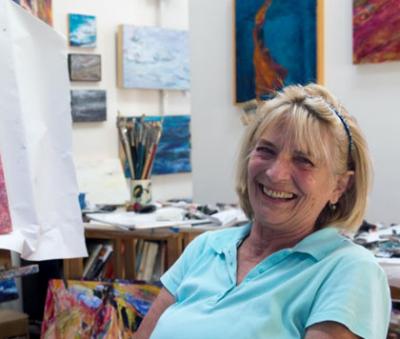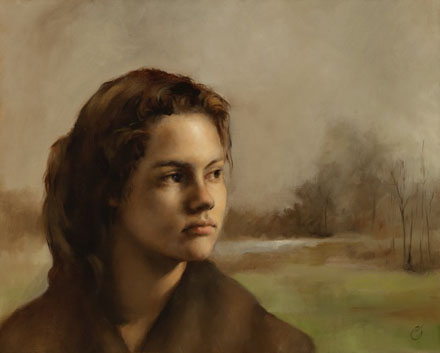
From the Primal to the Sublime- 2015 Holiday Art Studio Tour

I’ve always liked the saying, “If I knew the world was going to end tomorrow, I would plant an apple tree today.” Although often erroneously attributed to Martin Luther, it’s something he very well could have said, and I feel the sentiments behind it are rich and instructive. Some think Anne Frank’s father Otto said it. He would know something about impending destruction. Either way, the wisdom is clear: Never let the paralyzing effects of The End stop you from cultivating heaven on earth. Steward your little plot of land right up to the precipice. Let’s extend the metaphor from orchardist to artist: Go out and boldly and even foolishly paint, carve, sing, draw, scrimshaw, glassblow and monoprint your way right to the very edge of the apocalypse. Heaven on Earth is in part achieved by artists following their vision and bringing to life their inner world which in some crazy circuitous way, helps us better understand and process this world around us. The 5 Vashon artists I’m going to highlight in this article about the upcoming 2015 Vashon Island Holiday Art Studio Tour are heroes to me in this regard. Anybody who consistently and boldly draws forth creative meaning from raw materials in the face of meaninglessness is a hero. And the more scary and confused the world gets, the greater the hero they are. Too hyperbolic for you? Okay, how about this: They motivate and inspire my own work, and I think they will for you. Consider dropping by their studio and other studios on the tour on December 5th and 6th, and 12th and 13th, from 10am to 4pm, and see whose artwork lights your world. Once again, Arts Tour brochures with cool maps are available everywhere, from the IGA to Sandy’s grocery to all the ferries.
When I entered Carol Schwennesen’s studio, stop number 34, I immediately saw Carol as a torchbearer to a mythic and oceanic application of paint that finds its American origin in Albert Pinkham Ryder. When Carol is immersed in her paintings, she would rather be disoriented and “into the mystic”; compounding her paint like Albert Pinkham Ryder did, throwing monkey wrenches and varnishes into the mix like he did, and groping for the ineffable like his proverbial inchworm on the end of a twig.
Carol Schwennesen’s studio and home are filled with large and small energetic and impasto layered oil paintings that demand not our attention, but our contemplation. This is a mature and seasoned artist who has spent decades exploring the power of paint. Slow down. Sit with these. They’re not going to spell it out for you. These paintings are operating on another deeper, less literal level. These are paintings you live with, that grow with you. But don’t think you’re not smart or educated enough to understand these, dare I say, non-representational paintings (I refuse to use the “A” word!). I liken her paintings to the ability of roughly textured ceiling plaster to suggest forms. One might see a range of faces and shapes on the plastered ceiling on one day. But on other days in different light their texture shifts and the images are gone. Carol Schwennesen’s paintings do the same thing. On a very basic level, Carol is a professional plasterer, and a rebel one at that. But she uses colorful oil paint instead of plaster, and, to paraphrase painter Susan Rothenberg, surprises herself with every stroke of paint. “One reason I don’t paint optical reality is because I know I can do it- I need the guts not the skin”. Carol says she almost “feels like Archimedes’ water screw lifting the paint up, out, around and above the surface of the canvas.” Carol embraces a “paint-from-the-gut” school of thought, where the basic elements of creation and consciousness swim beneath the surface of the paint, and basic instincts guide her brush, not the classical traditions of the 19th century atelier. At some point, all titles of “modern” and “contemporary” fade and, and I see a connection between Carol’s paintings and cave paintings from 17 to 33,000 years ago. There’s something very similar in both approaches to defining reality between those ancient cave paintings and in Carol’s gestural brush strokes with tenuous lines subsumed in oil paint. 1000s of years of human history can seem to vanish when Schwennesen, Twombly and Rothenberg paintings, among others, are put side by side with breathtaking Lascaux, Altimira, and Chauvet cave paintings. Are we full circle yet?
Also showing with Carol are her students Mary Lawrence and Ann Nicklason.
Not your cup of cider? That same 19th century atelier is alive and well in Erin Schulz’s studio, stop 32, way down Glen Acres Road. Where early in life Carol Schwennesen rebelled against a tide of a representational art culture, Erin began her career painting realistically against a tide of abstraction. Today she oil paints constantly, in the house, in the studio, even in the passenger seat of the car while driving through North Dakota. Many beautifully painted figures, still lives, portraits, and landscapes line her studio wall.

Early on, Erin was an English major, studying many writers and exploring Streams of Consciousness. She became adept at Critical Analysis, and got good at finding patterns and commonalities between different texts. This led her to become a Product Design Researcher, and this skill fed into her love of well designed objects, which give her as much pleasure to behold as to paint. Erin’s still lives, with their teapots, pewter cups, fruit and flowers are exquisite and calming. Her figures are expertly drawn and often hauntingly painted with emotional expression residing in the nuance of a glance, or a tilt of the head. She understands the effectiveness of a muted and limited palette. Her color sense is masterful. Erin immersed herself in the rigorous training of the Gage Academy in Seattle, a reviver and bastion of those very classical skills that modernism eschewed. This school of art, and others like it which Erin has attended, are the 21st century’s response to what they see as the only alternative to the dead end of modernism and its clever ironies: A return to French Atelier basics that elevate sacred geometry, The Golden Section, learning from nature and exercising high standards of figurative draughtsmanship. These are beautiful and appealing paintings.
Marcus Fellbaum (stop 22 on Cove Rd.) found his inspiration in van Gogh and Pacific Northwest skies with dark ominous rolling clouds against a Prussian blue sky. Also a direct and visceral painter, Marcus works on large canvases with acrylics, which dry fast allowing him immediate satisfaction in layering and scraping away- and giving him the license he desires to alter reality. I was drawn to the explosion of color in his large energetic paintings of ferry docks, lakes, salmon, jellyfish, and lighthouses. I aspire to the liberty with paint that Marcus employs. Why should the sky always be blue? Why should a green shirt only be green?! Marcus finds analogous and even complimentary colors to juxtapose to his local color. He applies an “all-over-ness” to his landscapes that makes these paintings vibrate like they have their own inner black light. He has found he cannot be hemmed in by reality. “You can’t jump out of your skin- you are who you are- I feel myself restricted by reality”. He tried to paint in a more restrained manner once and it gave him a claustrophobic reaction. Nevertheless, he has transitioned in recent years to delegating his color more deliberately with planned compositions of salmon swimming through the transition.
The Family Reimnitz presides over stop number 8 at the end of Kingsbury Rd on Maury Island, the studio of this generous and gracious couple, Ilse and Hartmut, and their son Gunter. I felt immediately at home with them. They gave me lots of time to look over decades of work, and proudly showed me their son Gunter’s steel sculptures. I was very motivated and inspired by what I saw. This talented home is an Only-On-Vashon-Must–See artistic Institution.
Hartmut has a prolific array of medium and small paintings largely based on his love of Alaska and drawing on a lifetime of commercial fishing there. You’ll find paintings of hard working fishermen, lovingly rendered fishing villages, forests, beaches, overcast days that still make you squint, and close up views of canna lilies and other wild flowers that remind me of Martin Johnson Heade. Hartmut has other beach paintings that remind me of another Hudson River School painter, John Frederick Kensett. They both garden right next to their studio and let nature’s beauty and symmetry work its way right into their paintings and prints. Hartmut has blossomed in recent years, immersing himself more and more into his painterly world.
Ilse, whose prints and watercolors hang in countless homes and offices, carefully explained her marvelous process in developing her stunning prints. Each print often goes through as many as 20 or 30 stages before a final image is achieved. And remember, these are monotypes- there is only one! Ilse does not run an edition of prints. This work truly has an inner glow on a sublime level. When I look at an Ilse print (or watercolor, or innovative combination of each) I feel transported down into the jungle of the garden and become a beetle or grasshopper smelling, seeing and feeling a menagerie of flora through blades of grass. I have been deposited in a world that seems more imbued with light, color, dew, and atmosphere than my own back yard. At any stage in the birth of an Ilse print, the subject matter can turn on a dime. The random pouring of ink instructs Ilse to now go botanical or maybe go figurative, or landscape, nocturnal, aquatic or aviary, to name a few options. Her mastery of color is all purely instinctual at this point, with those turn on dime decisions drawing on a lifetime of knowledge and experience.
Also represented there are the iron and steel sculptures of their son Gunter. Gunter’s crows, roosters and salmon play whimsically with the wind and sun, twirling and flapping in the wind, and casting shadows when placed against a wall. These delightful sculptures guard and play on the Reimnitz’s yard and will plentifully fill the first room of the studio.
There you have it- from the primal to the sublime. And these are just four of the 35 stops on the tour. Again, the Holiday Arts Tour will be held the first two weekends in December, the 5th-6th and the 12th-13th, from 10 am to 4 pm. And remember to heroically and defiantly create something beautiful in the face of Henny Penny’s cries of skies a falling!
- Login to post comments
